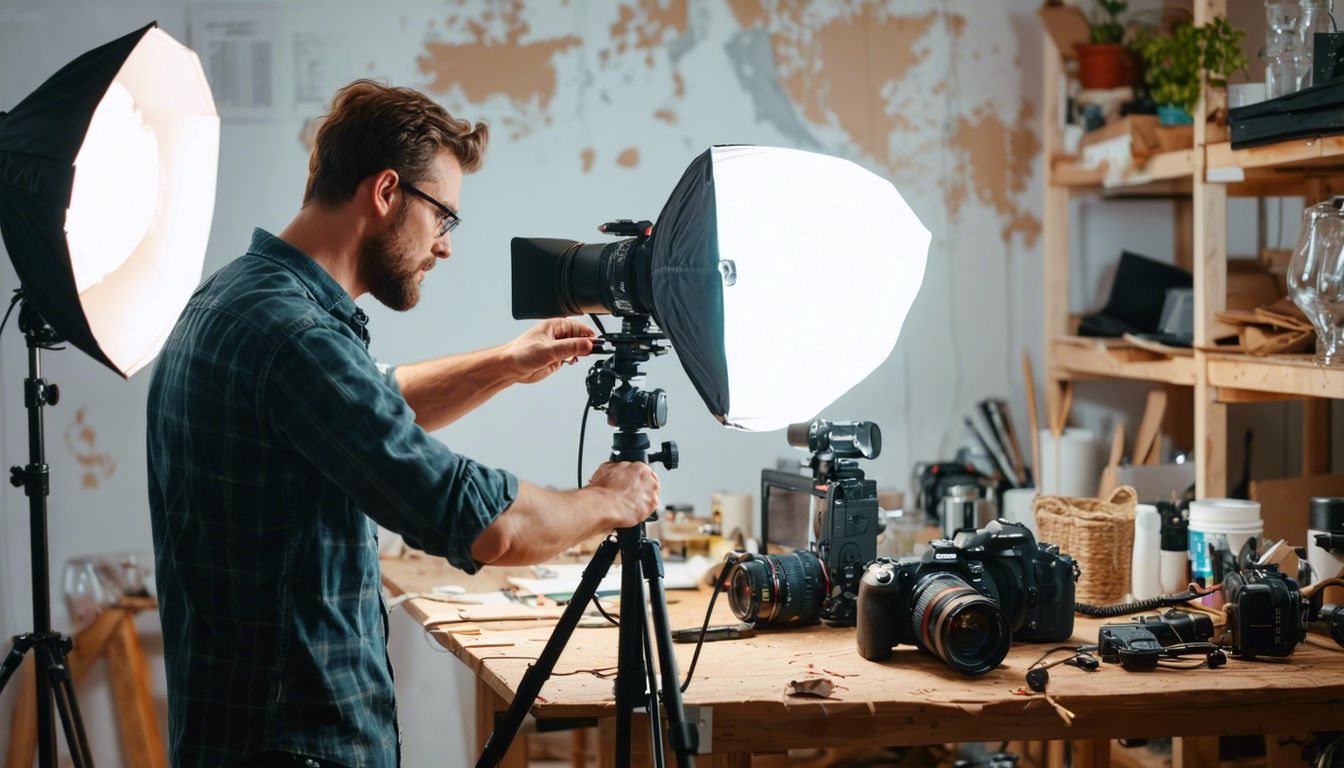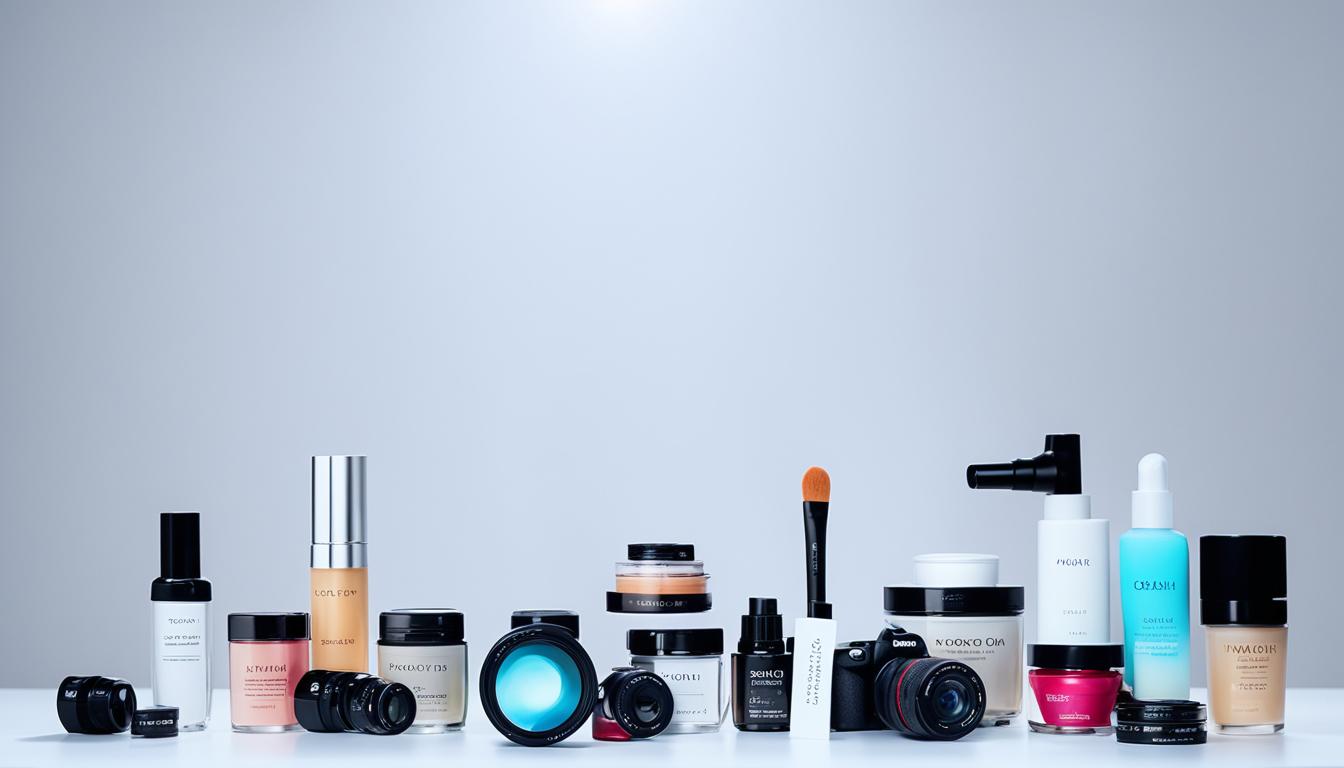Building a product photography portfolio is essential for showcasing your talent, attracting clients, and establishing yourself as a professional photographer. A well-crafted portfolio allows you to display your skills and creativity, making it easier for potential clients to envision working with you. Whether you are a beginner looking to build your first portfolio or an experienced photographer seeking to expand your body of work, this guide will provide you with valuable tips and strategies to create a compelling product photography portfolio.
Key Takeaways:
- Building a product photography portfolio is crucial for showcasing your talent and attracting clients.
- Invest in essential equipment such as a camera, tripod, white background, and bounce cards to set up a photo studio on a budget.
- Focus on taking high-quality product photos, paying attention to lighting, composition, and angles.
- Include both product-only shots and lifestyle shots to provide a comprehensive view of your work.
- Regularly update your portfolio with new work and remove outdated images to keep it fresh and relevant.
Essential Equipment for Product Photography
When it comes to creating a product photography portfolio, having the right equipment is essential. The following items will help you capture stunning product images that will impress potential clients:
Camera
A high-quality camera is the cornerstone of any product photography setup. Whether you choose a high-end DSLR or utilize the advanced camera technology found in smartphones, make sure to select a camera that suits your needs and budget.
Tripod
A tripod is an indispensable tool for product photography. It ensures stability and helps eliminate blurriness, especially when shooting in low-light conditions or using longer exposure times.
White Background
A clean, white background creates a professional look and allows your product to stand out. You can use a poster board, professional backdrop, or even a white tablecloth to achieve this effect.
Bounce Cards
Bounce cards made of foam board are used to reflect light and enhance the lighting of the product. They help reduce shadows and create an even distribution of light, resulting in well-lit and captivating product images.
Table
A stable surface, such as a table, is necessary for setting up your product and creating a consistent shooting environment. Ensure that the table is clean and clutter-free to maintain a professional aesthetic.
Tape
Tape plays a crucial role in securing the background, bounce cards, and other elements of your setup. It helps ensure everything stays in place during the photoshoot, preventing any distractions or disturbances.
Room with Window
A room with a window provides natural lighting, which is highly desirable for product photography. The diffused light creates soft shadows and enhances the details of your product. Position your setup near the window to take advantage of this beautiful natural light.
By investing in these essential equipment items, you’ll have everything you need to capture stunning product images for your portfolio.
Tips for Taking Professional Product Photos
Taking professional product photos requires attention to detail and a good understanding of essential techniques. In this section, we will share valuable tips and tricks to help you capture stunning images that showcase your products in the best light.
1. Lighting is Crucial
The right lighting can make a world of difference in your product photography. Natural lighting from a window is ideal as it provides soft, diffused light that illuminates your products evenly. Position your product near the window to take advantage of this beautiful light.
2. Composition and Angles
The composition and angles you choose can greatly impact the visual appeal of your product photos. Experiment with different compositions, such as the rule of thirds, to create balance and interest. Also, try capturing your products from various angles to showcase different perspectives and details.
3. Stability with a Tripod
A tripod is a must-have tool for achieving stability and sharpness in your product photos. It helps eliminate camera shake, resulting in clearer images. Use a tripod especially when capturing close-up shots and for long exposure shots to maintain consistent clarity.
4. Know Your Camera Settings
Familiarize yourself with the settings and features of your camera. Adjust the aperture, shutter speed, and ISO to suit the lighting conditions and desired outcome. Taking the time to understand your camera will enable you to capture high-quality product photos, even with a smartphone.
5. Smartphone Product Photography
You don’t need an expensive camera to capture professional product photos. Smartphones today often come equipped with powerful cameras that can produce outstanding results. Experiment with different smartphone photography techniques, such as using the exposure lock and adjusting the focus manually, to enhance your images.
Remember, practice makes perfect. Take the time to experiment with different lighting setups, compositions, and angles to find your unique style. By implementing these tips and techniques, you’ll be well on your way to capturing professional-looking product photos that will elevate your portfolio.
Creating Product-Only Shots for Your Portfolio
When building your product photography portfolio, it’s crucial to include product-only shots that focus solely on the product itself. These shots have a clean background and aim to provide potential customers with a clear idea of what the product looks like in a professional and appealing manner.
To capture high-quality product images and showcase your products effectively, it’s important to create a simple setup and declutter the scene. Start by using a white backdrop, whether it’s a poster board or a professional backdrop, to achieve a clean and sleek look. This helps draw attention to the product and avoid distractions.
Additionally, ensuring even lighting without shadows is key to producing stunning product images. You can achieve this by using bounce cards made of foam board to reflect and enhance the lighting. These bounce cards help create a well-lit environment, emphasizing the product’s features and details.
By keeping the focus on the product and decluttering the scene, you can capture product-only shots that stand out in your portfolio. This allows potential customers to see the products clearly and make informed decisions when browsing online stores.
Remember, clean background product photography with a simple setup and decluttered scene is crucial for showcasing your products in online stores and attracting customers with high-quality images. By following these practices, you can create captivating product-only shots that highlight your products’ best features.
Creating Lifestyle Shots for Your Portfolio
In addition to product-only shots, it’s crucial to include lifestyle shots in your product photography portfolio. These shots offer a glimpse into how products are used in real-life settings, allowing customers to connect with your brand on a deeper level.
Lifestyle product photography is a powerful tool for creating emotional connections with customers. By showcasing your products in real-life scenarios, you can evoke emotions and memories that resonate with your target audience.
Adding variety to your product portfolio is essential for capturing the attention of potential clients. Lifestyle shots provide a refreshing change from the traditional product-only images, allowing you to showcase the versatility and functionality of your products in a more relatable way.
Through storytelling in photography, you have the opportunity to create a narrative around your products. Think about the story you want to tell and the message you want to convey. Consider the experience you want customers to associate with your products, and capture shots that reflect that.
Lifestyle shots can be used across various marketing platforms, including websites, social media, and other promotional materials. By incorporating these images into your portfolio, you’ll enhance the overall storytelling of your brand and engage your audience in a more meaningful way.

Capturing lifestyle shots allows you to showcase your products in real-life settings, creating emotional connections with customers.
By including lifestyle shots in your product photography portfolio, you’ll demonstrate not only the functionality of your products but also the relatability and value they bring to customers’ lives. It’s an opportunity to go beyond the surface and showcase the experience your products provide.
“Lifestyle shots allow you to paint a vivid picture of your products in action, creating a strong emotional connection with your audience.” – Jane Johnson, Professional Product Photographer
Tips for Building an Effective Photography Portfolio
Building an effective photography portfolio requires careful consideration and thoughtful curation. Your portfolio is a representation of your skills, style, and versatility as a photographer. Here are some essential tips to help you create a compelling portfolio that attracts potential clients:
Showcase Your Best Work
When selecting images for your portfolio, focus on showcasing your absolute best work. Choose photographs that highlight your technical expertise, creativity, and unique style. These images should make a strong first impression and leave a lasting impact on viewers.
Demonstrate Adaptability
In addition to showcasing your best work, it’s crucial to demonstrate your adaptability as a photographer. Include a variety of images that explore different genres, techniques, and subjects. This shows potential clients that you can handle diverse assignments and capture exceptional photographs in various scenarios.
Set Up an Online Store
An online store can be a valuable addition to your photography portfolio. It allows clients to purchase your prints or hire your services directly, providing a convenient way for them to support your work. By integrating an online store, you not only showcase your talent but also create opportunities for revenue generation.
Regularly Update Your Portfolio
Keeping your portfolio up to date is vital for staying relevant and attracting new clients. Regularly add new work that represents your current skills and style, and remove outdated images that no longer reflect your capabilities. By regularly updating your portfolio, you show clients that you are actively engaged in your craft and consistently producing high-quality work.
Remember, a photography portfolio is not a static collection but an evolving representation of your talent and growth as a photographer.
Continuously Refine and Improve
Building an effective photography portfolio is an ongoing process. Continuously refine and improve your portfolio by seeking feedback from trusted peers, mentors, or industry professionals. Their insights can help you identify areas for improvement and make necessary adjustments to enhance the overall impact of your portfolio.
By following these tips, you can create a photography portfolio that effectively showcases your talent and attracts potential clients. Remember, your portfolio is not simply a collection of photographs but a powerful tool that communicates your unique vision and capabilities as a photographer.
Choosing the Right Website Builder for Your Photography Portfolio
When it comes to creating a photography portfolio website, selecting the right website builder is essential. It plays a pivotal role in showcasing your work and maximizing your online presence.
Look for a photography portfolio website builder that offers customizable portfolio templates tailored specifically for showcasing photography portfolios. These templates provide a solid foundation and allow you to customize the design according to your unique style and brand.
An intuitive and user-friendly design is crucial to ensure a seamless website-building experience. You want a website builder that allows you to easily customize and modify the layouts, fonts, colors, and other elements of your website. This empowers you to create a visually appealing and cohesive online portfolio that reflects your artistic vision.
Flexibility is key when it comes to presenting your photography. Look for a website builder that offers a variety of flexible layouts, such as grid, gallery, full-screen, and horizontal scroll options. This allows you to showcase your photos in the best possible way, depending on the style and mood you want to convey.
In today’s digital age, the inclusion of multimedia elements is essential. Having video support enables you to showcase dynamic content, such as behind-the-scenes footage, tutorials, or video portfolios. This adds depth and engagement to your photography portfolio.
Client proofing galleries are a valuable feature, especially if you offer services such as client shoots or collaborations. These galleries allow your clients to view, select, and approve their photos directly on your website, streamlining the workflow and enhancing the client experience.
Search Engine Optimization (SEO) optimization is another crucial aspect to consider. A website builder with built-in SEO tools and features can help improve your website’s visibility in search engine results, making it easier for potential clients to discover your work.
A built-in blog is a great addition to your photography portfolio website. It allows you to share behind-the-scenes stories, tips and tricks, and industry expertise. This not only adds value to your visitors but also helps establish you as an authority in your field.
Lastly, prioritize a website builder that offers reliable and accessible customer support. Having prompt and knowledgeable assistance at hand ensures that any technical issues or questions are quickly resolved, allowing you to focus on your photography.
Comparison of Top Photography Portfolio Website Builders
| Website Builder | Customizable Templates | User-Friendly Design | Flexible Layouts | Video Support | Client Proofing | SEO Optimization | Built-in Blog | Customer Support |
|---|---|---|---|---|---|---|---|---|
| Website Builder 1 | Yes | Yes | Yes | Yes | No | Yes | No | 24/7 Live Chat |
| Website Builder 2 | Yes | Yes | Yes | No | Yes | No | Yes | Email & Phone Support |
| Website Builder 3 | Yes | Yes | Yes | Yes | Yes | Yes | Yes | 24/7 Live Chat |
By carefully considering these factors and evaluating different website builders, you can make an informed decision and choose the website builder that best suits your needs. Remember, your photography portfolio website should not only showcase your work but also reflect your unique style and vision.

With the right photography portfolio website builder, you can create a visually stunning and functional online portfolio that effectively showcases your photography, attracts clients, and establishes your professional presence in the digital realm.
Conclusion
Building a product photography portfolio is essential for showcasing your skills and attracting clients. By following the tips and strategies mentioned, you can create a professional and captivating portfolio that effectively highlights your talent and style.
Remember to invest in the necessary equipment, such as a camera, tripod, and lighting tools, and pay attention to lighting, composition, and angles when taking product photos. These factors can greatly enhance the quality of your images and make them more visually appealing.
Incorporate both product-only shots and lifestyle shots in your portfolio to provide a comprehensive view of your work. Product-only shots allow potential clients to focus solely on the product, while lifestyle shots showcase the product in real-life settings and help create emotional connections with customers.
Building an effective photography portfolio is an ongoing process. Select your best work, demonstrate adaptability by including a variety of images, and regularly update your portfolio to keep it fresh and relevant. Additionally, choose a website builder that offers customizable templates and user-friendly design to create a visually appealing and functional photography portfolio website. This will ensure that your portfolio stands out and captures the attention of potential clients.
FAQ
What equipment do I need for product photography?
To set up a product photography studio, you’ll need a camera, tripod, white background, bounce cards made of foam board, table, tape, and a room with a window.
What tips can help me take professional product photos?
Pay attention to lighting, composition, and camera settings. Utilize natural lighting from a window, use a tripod for stability, and learn how to adjust your camera settings. Even smartphones can be used for product photography with the right techniques.
How can I create product-only shots for my portfolio?
Create a clean setup and use a white backdrop to achieve a professional look. Declutter the scene and eliminate distractions. Ensure even lighting without shadows by using bounce cards made of foam board.
Why should I include lifestyle shots in my product photography portfolio?
Lifestyle shots show products in real-life settings, creating emotional connections with customers. They showcase product usage and add variety and depth to your portfolio.
What tips can help me build an effective photography portfolio?
Showcasing your best work, including a variety of images, setting up an online store, and regularly updating your portfolio are important strategies to follow.
How do I choose the right website builder for my photography portfolio?
Look for a photography portfolio website builder with customizable templates, a user-friendly design, and flexible layouts. Consider features like video support, client proofing galleries, SEO optimization, and 24/7 customer support.
How important is building a product photography portfolio for attracting clients?
Building a product photography portfolio is essential for showcasing your skills and attracting clients. It allows you to highlight your talent and style and helps create a strong first impression in the competitive photography market.
How Should I Showcase Client Expectations and Deliverables in My Product Photography Portfolio?
When compiling a product photography portfolio, it’s crucial to showcase how you have met product photography client expectations deliverables. Highlighting successful projects, before-and-after images, and client testimonials can effectively prove your ability to meet and exceed client expectations while delivering high-quality results.




